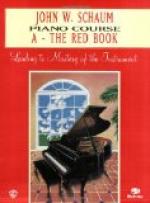I explained that I needed some new ideas in my teaching, and wished to keep up my own practise.
“I will explain my theories to you, and we will then study some compositions together.
“There is everything in knowing how to practise, but it is something that cannot be taught. I played in public ten years before I found out the secret.
“Practise slowly and in sections. Not only must all the notes be there, they must be dwelt on. There must be a firm and rock-like basis for piano playing; such a foundation can only be laid by patient and persevering slow practise. If the player has not the control over his fingers to play a piece slowly, he certainly cannot play it fast. Slow practise—one difficulty at a time—one hand at a time; Napoleon’s tactics, ‘one division at a time,’ applies to music study. Above all do not hurry in fugue playing, a universal fault. Bach needs a slower trill than modern music. Chords are not to be played with percussion but with pressure. The main things in piano playing are tone and sentiment. When you take up a new piece, practise a few measures slowly, till you know them, then play faster; take the next few measures in the same way; but at first do not practise the whole piece through at once.
“Just as in life every experience of great joy or great grief leaves one better or more callous, so every time you practise you have either advanced or gone back. Right playing, like good manners in a well-trained child, becomes habitual from always doing right. As we are influenced for good or evil by those we associate with, so are we influenced by the character and quality of the tones we make and hear. Be in earnest; put your heart, your whole soul, your whole self into your playing.”
Among other pieces we studied together was the Schumann sonata in F minor, the Eusebius Sonata—a glorious work! In the opening movement the left hand should be very serious and ponderous, with the hand and fingers held close to the keys; using arm weight. The melody in octaves in right hand is beseeching, pleading, imploring. In many places the touch is very elastic. The second movement begins very softly, as though one heard something faintly in the distance, and did not quite know what it was, but thought it might be music. The accents in this movement are to be understood in a comparative degree, and are not as strong as the marks seem to indicate. The Scherzo is extremely pompous and is to be played with heavy accents and a great deal of vim and go; the chords with the utmost freedom and dash. One must use the “letting-go” principle, which Paderewski has to perfection.
We next took up the Grieg Concerto; the Peter’s edition of this work has been corrected by the composer. At the first lesson, Dr. Mason accompanied on a second piano, and seemed pleased with the work I had done, making no corrections, except to suggest a somewhat quicker tempo. “Not that I would do anything to impair your carefulness and accuracy, but you must take a risk, and from the beginning, too. I am reminded of the young man who has been very carefully brought up. When the time comes for him to strike out and take his chance in life, he holds back and is afraid, while another with more courage, steps in and takes away his opportunity.”




